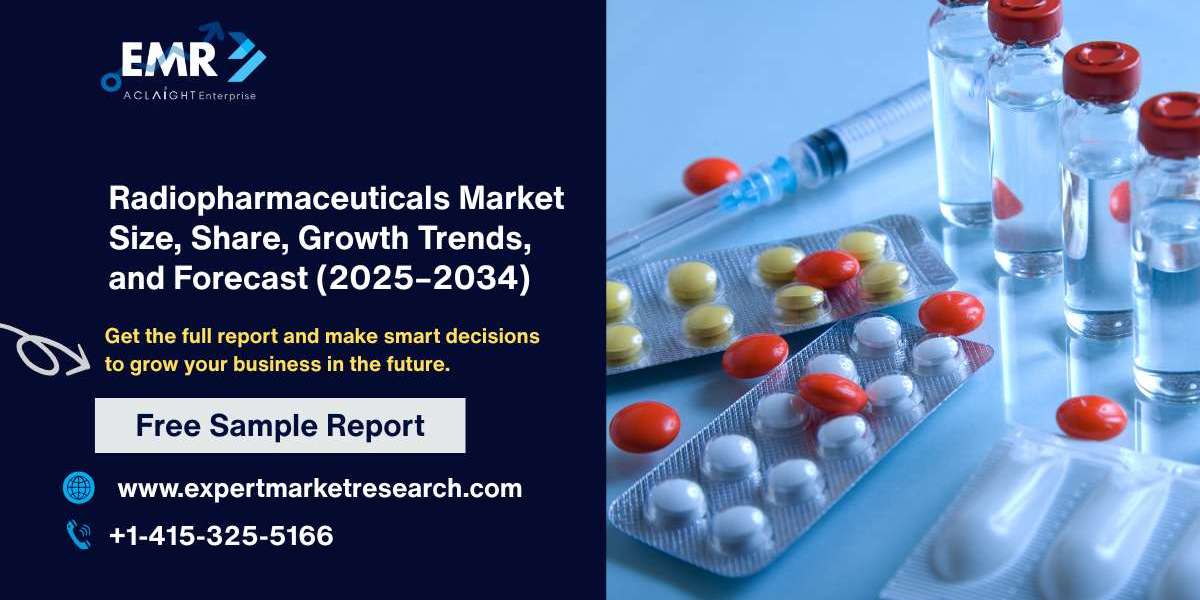Radiopharmaceuticals Market Overview
The radiopharmaceuticals market was valued at USD 7.06 billion in 2024 and is projected to reach USD 15.67 billion by 2034, expanding at a CAGR of 8.30% during the forecast period. This growth is driven by the rising demand for advanced diagnostic imaging and targeted therapies, especially in oncology and neurology. Radiopharmaceuticals are becoming central to modern medical practice, offering both diagnostic and therapeutic functions through targeted radioactive compounds.
With increasing adoption of PET and SPECT imaging technologies, along with expanding clinical use of radioligand therapies, the market is expected to grow substantially across developed and emerging regions alike.
Market Dynamics
Key Growth Drivers
Rising Cancer Prevalence: Growing cancer incidence worldwide is accelerating the use of radiopharmaceuticals for both imaging and treatment, particularly in prostate, breast, and neuroendocrine tumors.
Advancements in Theranostics: The integration of therapy and diagnostics (theranostics) is driving real-time treatment personalization, improving clinical outcomes and enhancing patient care.
Government and Private Investment: Funding in radiopharmaceutical R&D and manufacturing capacity is rising globally, with public-private partnerships fostering innovation.
Precision Medicine Adoption: Radiopharmaceuticals support targeted treatment approaches, aligning with the growing global trend of personalized medicine.
Market Challenges
Short Half-Life of Radioisotopes: Rapid decay rates complicate distribution logistics and limit shelf life, especially in countries with limited nuclear medicine infrastructure.
High Production Costs: Radiopharmaceutical development and regulatory approval are capital-intensive, affecting cost competitiveness.
Opportunities
Neurological Applications: Increasing demand for early detection and treatment of Alzheimer’s, Parkinson’s, and other neurodegenerative disorders presents new avenues for growth.
Next-Gen Isotope Development: Expanding use of isotopes like Actinium-225 and Lutetium-177 for targeted therapies offers a significant market opportunity.
Radiopharmaceuticals Market Segmentation
By Type
Diagnostic Radiopharmaceuticals: Widely used in PET and SPECT scans for non-invasive imaging. PET agents such as Fluorine-18 and Gallium-68 are gaining traction for precision diagnostics.
Therapeutic Radiopharmaceuticals: Gaining popularity in oncology, especially for targeted radioligand therapies (RLT) in prostate and neuroendocrine cancers.
By Source
Cyclotron-Based
Nuclear Reactor-Based
Cyclotron-produced isotopes are gaining popularity due to quicker, decentralized production capabilities, especially for short-lived isotopes like Fluorine-18.
By Radioisotope
Technetium-99m: Dominates the diagnostic segment due to its excellent imaging characteristics and compatibility with SPECT.
Fluorine-18: Preferred in PET imaging for high-resolution diagnostics.
Iodine I, Gallium-68, Radium-223, Zirconium-89: Used across diagnostic and therapeutic applications with increasing demand for cancer care.
By Application
Cancer: Accounts for the largest market share, led by prostate, lung, and breast cancers.
Neurology: Significant growth driven by PET imaging for Alzheimer’s and other cognitive disorders.
Cardiology: Myocardial perfusion imaging using Technetium-99m remains a common application.
Others: Includes inflammatory and infectious disease imaging.
By End User
Hospitals: Dominant end user, leveraging integrated diagnostic and treatment capabilities.
Diagnostic Imaging Centers: Growing due to outpatient preference and reduced procedural costs.
Research & Academic Institutes: Driving innovation and early-stage development through collaborations and clinical trials.
Regional Insights
North America
Holds the largest share of the global radiopharmaceuticals market.
Strong infrastructure, high healthcare spending, and early adoption of nuclear medicine technologies drive growth.
The U.S. is a hub for innovation, with companies like GE HealthCare and Cardinal Health expanding their product portfolios and radiopharmacy networks.
Asia-Pacific
Fastest-growing region, driven by rising cancer burden, government investments, and expanding healthcare access.
Countries such as India, China, and Japan are increasing their nuclear medicine capacities, supported by public-private collaboration.
Growth in R&D and clinical trials is boosting the region’s radiopharmaceutical ecosystem.
Europe
Focused on regulatory harmonization, quality standards, and expanding access to molecular imaging technologies.
Major players like Novartis are investing in next-generation therapeutic radiopharmaceuticals.
Competitive Landscape
The market is witnessing consolidation, innovation, and cross-sector collaboration. Leading companies are strengthening their pipelines through M&A, licensing deals, and partnerships.
Key Players:
Novartis AG – Pioneering radioligand therapies (Pluvicto, Lutathera)
Bayer AG – Advancing alpha therapies for prostate cancer
Jubilant Pharmova Limited – Expanding U.S.-based radiopharma services
GE HealthCare – Deepening its diagnostics and radiopharma manufacturing
Lantheus Holdings Inc. – Focused on diagnostics and theranostics innovation
Curium Pharma, Cardinal Health, Siemens AG, RayzeBio, Iso-Tex Diagnostics
Recent Strategic Developments
March 2025 – Novartis received FDA approval for Pluvicto in earlier-stage prostate cancer treatment.
January 2025 – ITM’s Phase 3 trial of ITM-11 showed superior results for gastroenteropancreatic tumors.
June 2024 – Orano Med inaugurated the world's first industrial-scale lead-212 production facility in the U.S.
January 2025 – Eli Lilly partnered with Radionetics in a USD 140 million deal for radiopharma R&D.
October 2024 – Jubilant Pharmova launched a nuclear medicine solution with Simplified Imaging Solutions in the U.S.
Future Outlook
The global radiopharmaceuticals market is evolving rapidly with a strong emphasis on innovation, precision therapy, and expanding access. Breakthroughs in radioisotope development, strategic collaborations, and increasing regulatory support are reshaping treatment paradigms in oncology, cardiology, and neurology. With rising global healthcare demand and growing investments, the market is well-positioned for sustainable long-term growth.
Frequently Asked Questions (FAQs)
1. What is the projected size of the radiopharmaceuticals market by 2034?
The market is expected to reach USD 15.67 billion by 2034, growing at a CAGR of 8.30% during the forecast period.
2. What are radiopharmaceuticals used for?
Radiopharmaceuticals are used for both diagnostic imaging (e.g., PET and SPECT scans) and targeted therapies, especially in oncology, neurology, and cardiology.
3. Which radioisotope is most widely used?
Technetium-99m is the most widely used radioisotope due to its high imaging efficiency and short half-life, making it ideal for various diagnostic procedures.
4. What is driving growth in therapeutic radiopharmaceuticals?
Rising cancer prevalence, successful radioligand therapies, and demand for precision oncology are pushing growth in therapeutic radiopharmaceuticals.
5. Which region is leading the global radiopharmaceuticals market?
North America currently leads the market, while Asia-Pacific is the fastest-growing region due to improved healthcare access and rising cancer rates.
6. What challenges does the radiopharmaceutical market face?
Key challenges include the short half-life of radioisotopes, complex logistics, and high production costs, which can limit adoption in under-resourced regions.
7. How are companies innovating in this market?
Firms are investing in next-gen isotopes, personalized radiotherapy, and production facility expansions. Strategic acquisitions and collaborations are also fueling growth.
Company Name: Claight Corporation
Email: [email protected]
Toll Free Number: +1-415-325-5166 | +44-702-402-5790
Address: 30 North Gould Street, Sheridan, WY 82801, USA
Website: www.expertmarketresearch.com



